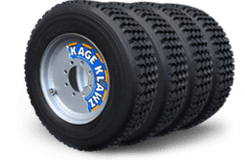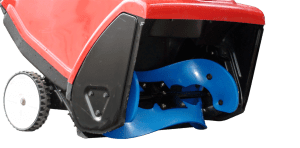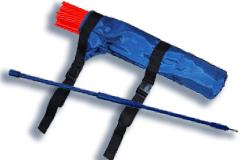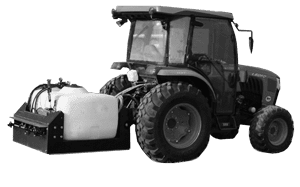
Compact Loader Articulation – A Benefit Or Disadvantage?
Articulation is the means by which the CWL (Compact Wheel Loader) turns itself. Commonly the wheel loader has an operator station much like a tractor, forklift, or truck. It utilizes a steering wheel, hydrostatic forward and reverse, gas, and brake / clutch peddles. The CWL articulates, or in other words, pivots in half between the front and rear axles in order to turn. This type of steering action can be an advantage, or a detriment depending upon what you are looking for.
Swing
The swing of articulation can sometimes be a detriment, especially if you are inexperienced. Allow me to elaborate. When you are turning the compact wheel loader, the entire machine pivots between the axles causing the boom to swing to one side or the other. If you have a large implement attached to the loader arms, such as a snow plow, you might experience unwanted movement, possibly into a nearby vehicle or other obstacle! On the other hand, the articulation means that your implement will always be perpendicular to the direction of travel. This can be a huge benefit when pushing snow, or loading dirt. As you turn a corner, the pusher or bucket will always be ‘square’ to your travel. You don’t have to spin, or make multiple back and forth movements to get ‘squared up’.
Lifting Capacity
Even large skid steers cannot boast the weight capacity that even small CWL’s have. By nature, the CWL is longer, and has more counterbalance than a skid steer so the tipping point is greater. One thing that you have to keep in mind when looking at this specification is that wheel loaders have a few different ratings when it comes to lifting capacity. They are rated at no turn, half turn, and full turn. This is because the more you are turned (articulated), the less you can lift and carry. By turning the CWL, the center of gravity changes and you risk tipping the machine.
Turning On Delicate Terrain
Landscapers are drawn to the compact wheel loader because of the flotation and turning it has. Because it is not a ‘skid steer’, there is much less turf damage when turning. Wheel loaders can be outfitted with large turf tires, which decreases the PSI and helps prevent rutting. On the other hand, certain tracked skid steers have the ability to turn on the turf without leaving so much as a mark because the weight is spread out over the entire track. In fact, some skid steers have a lower PSI rating than your footprint! You should always try to avoid aggressive turns with either piece of equipment, no matter what the PSI rating is.
Traction For Snow Removal
If you are a snow contractor, and your main reason for considering a CWL is because of your snow removal operations, traction should be on the top of the list of features you are considering. Traction can have a huge effect on your productivity, profitability, and service to your customer. The skid steer turns by propelling one side of the wheels or track faster than the other side. This causes a skidding effect. So, in essence, the skid steer needs to slip in order to turn. Traction, especially during a turn, is not the skid steer’s strong point. The CWL on the other hand can have all four wheels engaged with the ground during a turn. You even have the ability to lock up the differentials on some models. In general, a skid steer is not recommended to push anything greater than a 10 ft KAGE. The CWL can easily push the 10 ft KAGE, and we even make a 12 FT KAGE specifically for the CWL application.
Road Speed
Road speed can also be a big part of your consideration. Especially if you are planning to leave the machines parked onsite, and road them between your snow removal accounts. Keep in mind that wherever you are planning to park them, you want to have access to an electrical outlet so that you can plug in the block heaters. Nothing is worse than getting to your site with 2” of snow already on the ground and you can’t get your equipment started! Avoid that by coordinating with your customer(s) suitable parking spots for your equipment. Most property managers are more than willing to accommodate you in order to help you provide the best service possible. Road speed is important, and not all CWL’s or SSL’s are the same. Pay close attention to this when you are considering the different brands. In general, a two speed skid steer is designed to move about 12 MPH, while the top end of the Compact Wheel Loader is as much as 22 MPH. Now that is clipping along!
Operator Comfort
Operator comfort is a large piece of the equation. We’re not necessarily talking about having a heated leather seat embossed with a company logo and armrests, but basic comforts are necessary to efficiency. Let me explain. You need to be within reach of you main controls at all times. Visibility without straining your neck is important, and if your feet are always cold that’s no fun at all. Comfortable and useful operator platforms are very different between brands, so make sure that you are selecting the brand based on the operator comfort and use. In general, when comparing the CWL and the SSL, you can make some very general determinations.
Visibility
360 degree visibility is generally better in the CWL than in the SSL. The operator in the CWL is seated higher, and has more 360 degree visibility. You can clearly see your back rear corner in most CWL’s, while in a skid steer this is virtually impossible. For this reason backup cameras are starting to be used in the skid steer market. If you are worried about visibility, and the operator ‘neck strain’, the CWL is the way to go. The other aspect of visibility comes into play when you are loading and unloading trucks and trailers or doing dirt work. Operating a bucket for doing fine grading or dirt work, the skid steer will be the best choice hands down. You have a much closer encounter and visibility of your bucket edge in a skid steer. Pallet forks are the same way. If you are having to do loading and unloading of pallets, often the skid steer’s visibility will allow a faster, more accurate ‘pick’, especially when the trailer deck is 3’ off the ground.
Exiting And Entering The Equipment
Consider your ability to enter and exit the machine. Safety is important here. It can be hazardous climbing in and out of the machine, especially if the operator is in a hurry. Usually snow removal operators are, so this is important. Skid steers typically enter and exit over the boom, and you are climbing up over the boom (while it is dropped), spinning around, and sitting down into the seat. This is difficult, even for an agile operator. The compact wheel loader, is usually mounted from either side, and you simply climb a step or two to enter the cab and sit down into the seat. From and ease of entrance standpoint, the CWL is the better choice.
Motion Sickness
If you are like most people, excessive hard stops, spinning and reverse can cause some nasty motion sickness. This is only exasperated by excessive amounts of coffee and monster energy drinks! Skid steers are nimble and very maneuverable, but this can also make the operator sick. Snow removal is full of movements like this. In fact, to maximize your efficiency these quick and nimble movements are what you have to do. If you are like me, a CWL is a better choice if you experience motion sickness.
Manueverability & Turning – Skid Steer VS. Compact Wheel Loader
Probably one of the most distinctive differences is the maneuverability of the skid steer. The skid steer for the most part is much more maneuverable in tight spaces because of its zero turning radius, comparatively compact frame, and vertical lift. However, as previously discussed, the method of turning is very different and can have it own drawbacks.
Loading And Unloading Pallets
Loading and unloading pallets from trucks, such as you would commonly do at a nursery is probably easiest with a CWL. The visibility is not as good with the CWL as with a SSL, but turning with your load elevated is much safer and easier to do with the CWL. Also, as previously mentioned, the weight capacity is greater with the CWL.
Turning Radius
Clearly the biggest advantage of the skid steer is the zero turning radius. By skid – turning, you can literally turn around within the footprint of the machine. If maneuverability is your #1 concern you have to go with the skid steer loader. If you want good turning radius, but like all of the other features of the CWL, there are differences in the brands available out there. Make sure that you do the research on all of them. We have included a handy spec sheet below comparing two common models of two popular brands.
Overall Height
Consider the overall height if you have maximum height clearances. For instance, do you snow plow any parking ramps, or do you have to get under low clearance drive – up awnings? Are you trying to hop up onto sidewalks to clear them? Do you have low hanging light poles to worry about? For sidewalks in general, I would recommend a skid steer due to the overall weight, width, and turning ability. The compact wheel loader is definitely a concern if you are worried about low hanging obstacles. This decision alone might affect your ability later on to service these types of contracts.
Trailering
If your intention is to trailer this unit often, you should consider the weight, and truck / trailer size you will need to pull one vs. the other. If your sole reason for choosing a CWL over a skid steer is to get more pushing capacity for snow removal, you are probably looking at a medium – large class compact wheel loader. This might come with some extra weight restrictions and driver licensing that you were not considering. Keep in mind that most of the time if your GVWR is a combined (truck and trailer) of 26,000 LBS or greater, you will need at least a Class A license. Furthermore, if you are then operating a CV with air brakes, you need special licensing for that as well. Much of your decision could be based upon this, since it can be hard to find and train qualified Class A or B drivers, and purchase the special equipment to haul.
In summary, the compact wheel loaders are getting smaller, more compact, and hence more attractive as a suitable replacement to a skid steer. We just purchased our first CWL this year, and the features that helped us make the decision over the skid steer was Lift Capacity, Carrying & Loading Pallets, Road Speed, and Pushing Power. I hope that you found this article informative.
Of course, check out our SnowFire Skid Steer / Compact Wheel Loader Snow Plow Box System. We offer this in 6- to 12-foot plowing widths.
Below is the comparison chart for Cat and John Deere’s comparable machines.
































Recent Comments